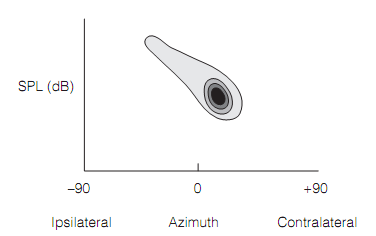Localization of sound
The capability to localize the source of a sound in space is very significant in evading danger. The coordinates of a sound source in horizontal and vertical planes are elevation and azimuth correspondingly. Various mechanisms are included in determining these two coordinates.
The pinna (i.e., outer ear) and ear canal act as direction selective filters for positioning sound elevation. Sound waves come in the ear either directly or reflected by pinna and ear canal and therefore will arrive at slightly diverse times at the ear drum. The delay times will base on the elevation of the sound source and the peculiarities of the external auditory system.
The superior olivary complex uses two techniques to localize sound in the horizontal plane. Both compare input into the two ears (i.e., binaural sound localization) and permit azimuth to be pinpointed with a accuracy of about one degree of arc:
- Interaural level differences (ILDs). Whenever the head is orientated, therefore one ear is closer to the sound source, and then the head forms a shadow that decreases the sound level entering the other ear. ILDs are unambiguous for frequencies > 1600 Hz for which the dimensions of the head are bigger than the length of the sound waves. ILDs as low as one dB can be noticed.
The neurons of lateral superior olivary nucleus (LSO) have a tonotopic map constrained largely to high frequency input. Such cells receive inputs from both contralateral and ipsilateral cochlear nuclei. Though, the contralateral route is by way of a glycinergic inhibitory neuron. Equivalent sound level in both ears causes overall inhibition of the LSO neuron and increasing the sound level in the contralateral only serves to augment the reservation. Though, increased sound level to the ipsilateral ear causes LSO firing. Maximum firing rate is seen whenever ILD is 2 dB or more. Consequently cells in the opposite LSO will illustrate reverse responses to similar sound. The LSO projects to the ventromedial section of the IC central nucleus. The IC joins extensively with the deep layers of the superior colliculus to form an auditory space map in register with the retinotopic map. Therefore the superior colliculus is implicated in the auditory reflexes organizing gaze and head rotation towards the sound source.
- Interaural time differences (ITDs). A sound wave enters the closer ear a little earlier than the further one. For low frequencies (< 800 Hz) this answers in a time delay less than one period that is analyzed by neurons capable of phase-locking. At high frequencies input into the furthest ear is delayed by more than a single period, and this makes phase-locking untrustworthy, therefore ITDs cannot give an unambiguous cue to position except by detecting delays in sound onset or offset. ITDs are as short as 20 µs can be detected. The neural system for measuring ITDs based on cells in the medial superior olivary nucleus (MSO) acting as coincidence detectors. The MSO has input from bushy cells in both cochlear nuclei which phase-lock in response to low frequency stimuli. When a phase difference exists among the two ears then the bushy cells corresponding to the farthest ear fire a little later. The MSO circuitry for transforming this timing difference to azimuth has been worked out for the owl, though the mammalian circuit is distinct and not yet understood.
Most of the cells in A1 are binaural and fall into two class of cortical columns. Those in summation columns show bigger responses to input from both ears than from one. By the contrast, cells in suppression columns have a preference for input from one ear as shown in figure. The summation and suppression columns are arrayed alternately and at right angles to iso-frequency strips. The position of a sound source seems to be encoded by a wide cortical channel in each hemisphere, instead of numerous channels tuned to discrete spatial locations.

Figure: Location tuned neuron in a suppression column of the auditory cortex. High density of shading corresponds to a greater firing rate.
The motion of a sound source can be examined from rises and falls in sound pressure levels. Rising intensity activates a neural network accountable for space recognition, sound motion, and attention that lies in the superior temporal lobe, right temporoparietal junction, right motor and premotor cortices, the left cerebellar cortex, and section of the midbrain. The special importance of rising intensity is that it outcomes from approaching (that is, potentially threatening) sources in natural atmospheres.